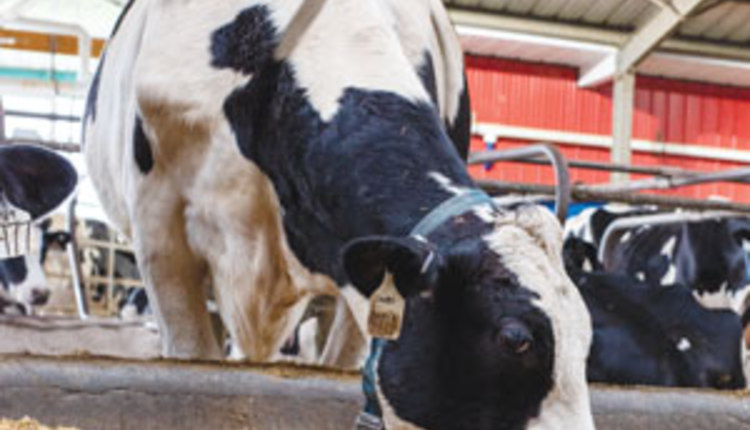Goeser is the director of nutritional research and innovation with Rock River Lab Inc., Watertown, Wis., and adjunct assistant professor, dairy science department, University of Wisconsin-Madison.

Straw originates as a by-product following small grain harvest. It’s used for both bedding and as a feed ingredient. As a feed ingredient, straw is multifaceted, with nutritionists bringing straw into diets for both functional fiber and low-energy nutritional aspects. Straw also can bring anti-nutritional factors, beyond what the eyes can see.
Straw for bedding
Wheat, barley, or rice straw make for great bedding, provided the straw is processed appropriately. Straw’s moisture wicking and insulation properties bring exceptional value to calves, heifers, and cows. At times, lesser quality straw finds its way to the hutches, bedded packs, or pens, and straw quality isn’t of much concern for bedding purposes, aside from moisture level.
A dry cow diet ingredient
Straw quality becomes more important as straw is brought into diets. Veterinarian Gordie Jones and University of Illinois’ Jim Drakeley, among others, led the charge a number of years back to bring straw into transition cow diets. Their work highlighted how straw improved transition cow performance, finding that straw contributes to a robust rumen mat. This mat subsists through calving during the substantial drop in dry matter intake around calving.
Prior to using straw or other high-fiber, low-digestibility feeds in close-up diets, the transition cow dry matter intake reduction at calving corresponded to the fiber mat breaking down when cows quit eating around calving. Ultimately, this equated to a less healthy rumen environment and happened at a time when the cows were extremely sensitive.
Straw-based diets were different. Straw provided bulk in the rumen for days after consumption due to the poor fiber digestibility and robust physical characteristics. Hence, the “Goldilocks” diet became a staple for many transition cow nutrition programs primarily due to the functional fiber attribute. Straw quality here is defined by fiber and mineral content and zero fungal or mycotoxin contamination.
Straw’s poor fiber digestibility also helps limit total dietary energy in replacement heifer diets. Straw can make sense to dilute corn silage or other high-energy forages when economics allow or other low-energy feeds are unavailable. In this case, straw keeps heifers from gaining too much condition as a bulky dietary ingredient that fills them up.
Useful in lactating diets, too
In the past decade, straw has expanded as a multi-tool and found its way into lactating diets. Straw’s functional fiber is key here. With extremely high-quality forages and more finely chopped forages, dry matter intake can outpace performance and feed conversion efficiency suffers.
Think of this like a teenage son drinking a gallon of milk every other day and eating everything in sight, yet not putting on any weight. In this situation, a little straw can come into diets to slow things down within the cows’ digestive tract.
The thought process and biology is similar to the dry cow diet approach, with straw adding to the rumen mat and slowing feed passage through the rumen. Straw doesn’t contribute any energy to the diet, which is counterintuitive, as most underperforming diets suffer from energy issues. However, straw makes sense in some situations as rumen health is a prerequisite to optimum feed conversion efficiency.
Watch for contamination
Mycotoxin concerns with straw are commonly understood. In years with cool and wet growing conditions, small grain fungal disease can be prevalent, and mycotoxin contamination in straw is an issue. There is no room for contaminated straw in diets, recognizing that contaminated straw in transition cow diets will be substantially more damaging due to higher straw intakes coupled with already stressed cows due to the transition period.
Mycotoxins aren’t the only contamination concern. Historically, I had perceived dry straw to be a stable feed without much potential microbial growth.
Moldy straw is obviously a concern, but I learned about another straw issue when my colleague Auburn Moyer and I started digging into straw spoilage yeast counts in Michigan over the past two years. The spoilage yeast levels in some cases were striking, with millions of yeast colonies per gram in straw.
Visually, the straw didn’t look any different from the classic desirable golden wheat straw, but Auburn and I found some straw was carrying a heavy load of spoilage yeast. If transition cow performance seems a bit sluggish with a Goldilocks diet, consider checking yeast levels in straw if mold and mycotoxin levels aren’t of concern.
The multi-use tool
Straw is unique, and just like my old multi-tool that continues to work in many different ways. As you use this tool on your farm and bring straw into diets for good reason, gain from the positive attributes but take into account several of the negative aspects to this nutritional multi-tool.











